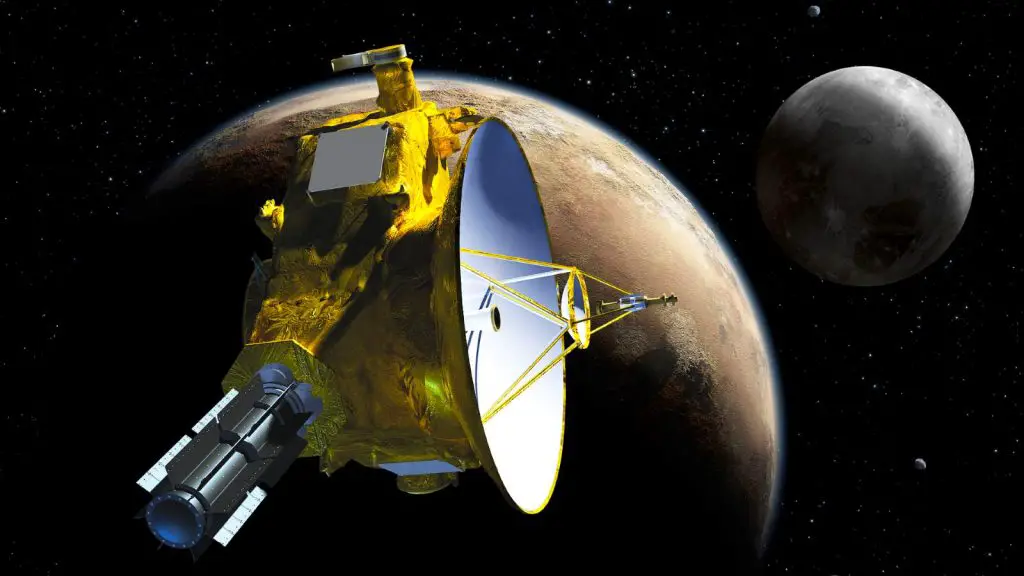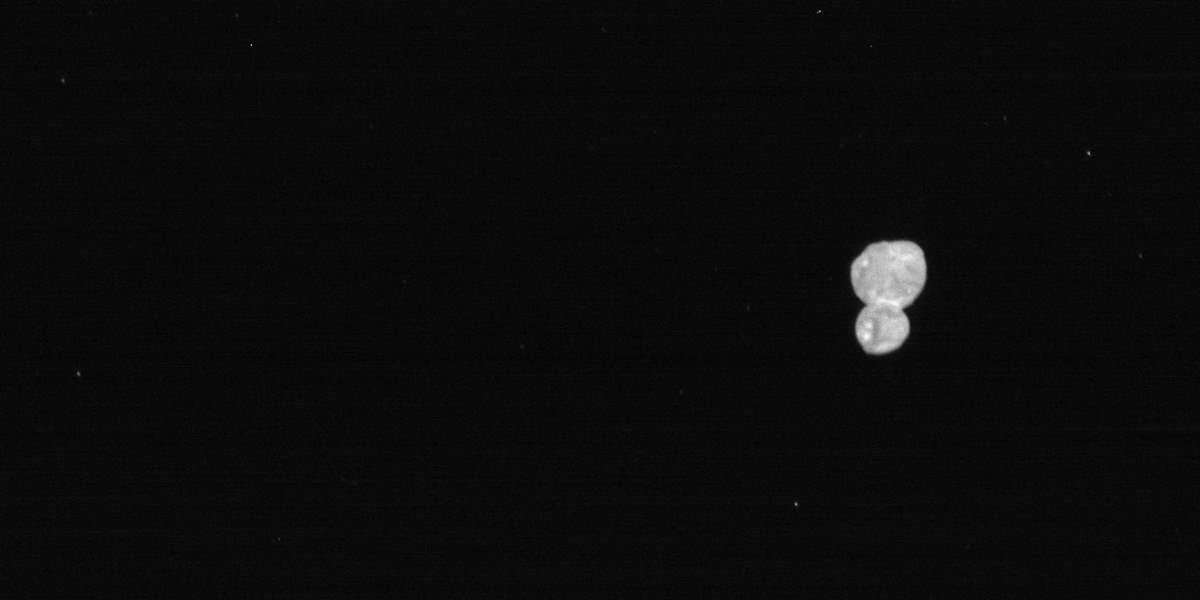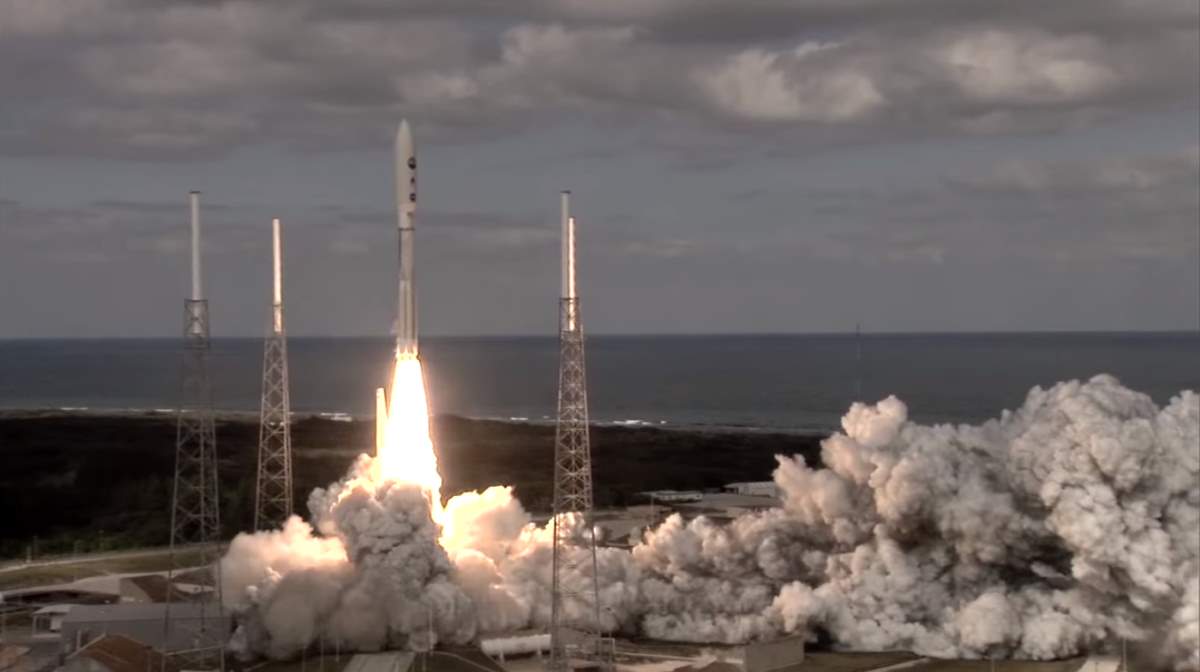A beautiful 486958 Arrokoth image (initially nicknamed Ultima Thule) taken by the Long Range Reconnaissance Imager (LORRI) aboard NASA’s New Horizons spacecraft in original context against a starry background (i.e., not zoomed in).
On January 1, 2019, the 486958 Arrokoth, provisional designation 2014 MU69 became the farthest object in the Solar System visited by a spacecraft.

486958 Arrokoth
486958 Arrokoth is a trans-Neptunian object (see notes 1) located in the Kuiper belt (see notes 2). It is a contact binary 31 km (19 mi) long, composed of two joined bodies 19 km (12 mi) and 14 km (9 mi) across.
These two bodies previously nicknamed “Ultima” and “Thule”, respectively (see notes 3).
486958 Arrokoth was discovered on 26 June 2014, more than eight years after the launch of New Horizons, by astronomers using the Hubble Space Telescope as part of a search for a Kuiper belt object for the New Horizons mission to target in its first extended mission.
Based on its position and the New Horizons spacecraft’s trajectory, this object was ideal for the spacecraft’s post-Pluto adventure.
Having completed its flyby of Pluto in July 2015, the New Horizons spacecraft made a total of four trajectory changes in October and November 2015 to place itself on a course towards 486958 Arrokoth.

The probe made its first detection of 2014 MU69 (486958 Arrokoth) on August 16, 2018, from a distance of 107 million mi (172 million km). It reached naked eye brightness (magnitude 6) from the spacecraft’s point of view just 3-4 hours before the closest approach. If obstacles were detected, the spacecraft had the option of diverting to a more distant rendezvous, though no moons, rings, or other hazards were seen. So no further trajectory changes needed.
High-resolution images from New Horizons were taken on January 1, 2019. The first images with medium resolution arrived on the next day
Notes
- A trans-Neptunian object (TNO) is any minor planet in the Solar System that orbits the Sun at a greater average distance than Neptune, which has a semi-major axis of 30.1 Astronomical Units (AU). An Astronomical Unit is the average distance between Earth and the Sun, which is about 93 million miles or 150 million kilometers. The first trans-Neptunian object to be discovered was Pluto in 1930, which was considered as the ninth planet of the solar system for a long time, until 2006. It took until 1992 to discover a second trans-Neptunian object orbiting the Sun directly, 15760 Albion. The most massive TNO is Eris, followed by Pluto.
- The Kuiper Belt stretches from about 30 (the orbit of Neptune) to about 55 astronomical units (AU) from the Sun. It is similar to the asteroid belt, which is located roughly between the orbits of the planets Mars and Jupiter but is far larger- 20 times as wide and 20 to 200 times as massive. Like the asteroid belt, it consists mainly of small bodies or remnants from when the Solar System formed.
- Thule is the farthest north location mentioned in ancient Greek and Roman literature and cartography. In classical and medieval literature, Ultima Thule (Latin “Farthermost Thule”) acquired a metaphorical meaning of any distant place located beyond the “borders of the known world”. In Germany, some Nazis believed in a historical Thule, or Hyperborea, as the ancient origin of the “Aryan race”. For that reason, some astronomers and historians strongly opposed the nickname. There’s still some debate about that. The New Horizons team also plans to submit a proper name to the International Astronomical Union when the nature of the object is better known.
Sources
- 486958 Arrokoth (2014 MU69) (Ultima Thule) on Wikipedia
- LORRI Images from the 486958 Arrokoth (Ultima Thule) Flyby on NASA’s New Horizons Mission page
- Thule on Wikipedia
- New Horizons on Wikipedia
- Space Shuttle Endeavour’s Touchdown Meets Columbia’s Salute [An amazing photo from the past] - February 29, 2024
- Moon Landings: All-Time List [1966-2024] - February 23, 2024
- From Orbit to Ordinary: 10 Earthly Applications of Space Technology - January 23, 2024

